This Rava modak recipe is an easy variation of modak made with semolina or sooji and stuffed with a sweet filling of jaggery and fresh coconut. They don’t need to be steamed and so the cooking time is greatly reduced. You can make these semolina modak for Ganesh Chaturthi festival or as a sweet snack.
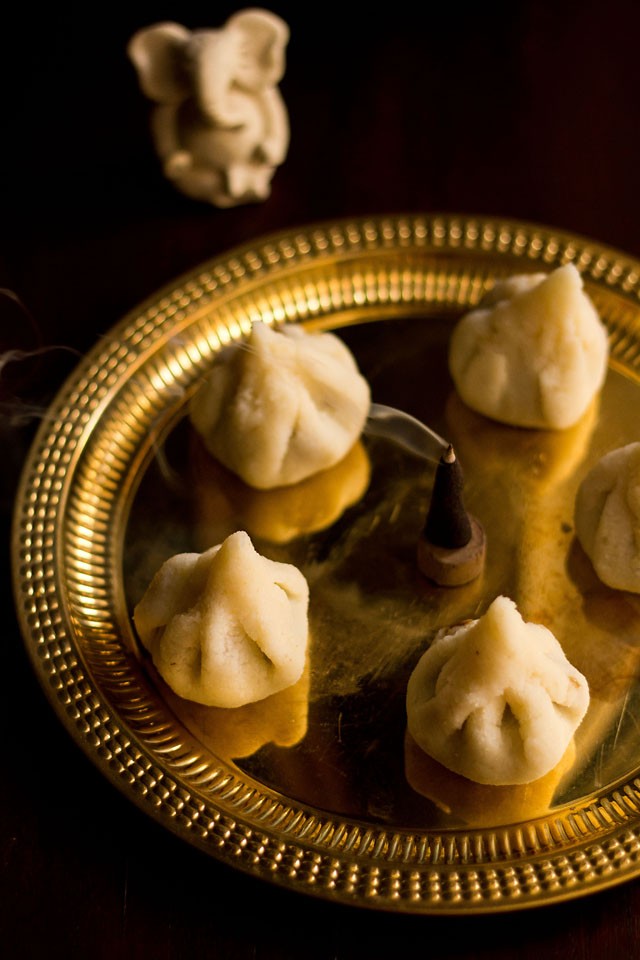
About This Rava Modak
I recently made this sweet and thought of sharing the recipe with you. The traditional version of modak is made with rice flour and stuffed with coconut and jaggery filling. I have already shared the traditional Maharashtrian recipes of:
In this recipe, as the name suggests, fine sooji or rava is used to make the outer cover. The filling is made of coconut and jaggery. Taste-wise it is similar to the modak made from rice flour.
This is an easy method as it takes less time, but the effort is there. It takes less time as you don’t need to steam them.
I have very sweet memories associated with Modak and I guess that will be case with many of you who celebrate Ganesha Chaturthi festival.
Modak is one of the favorite sweet of the Hindu God, Bhagwan Ganesha and is specially prepared as a prasadam during the Ganesha festival.
Bhagwan Ganesha also loves ladoo. So Coconut ladoo and Rava ladoo are also made during Ganesh Chaturthi festival.
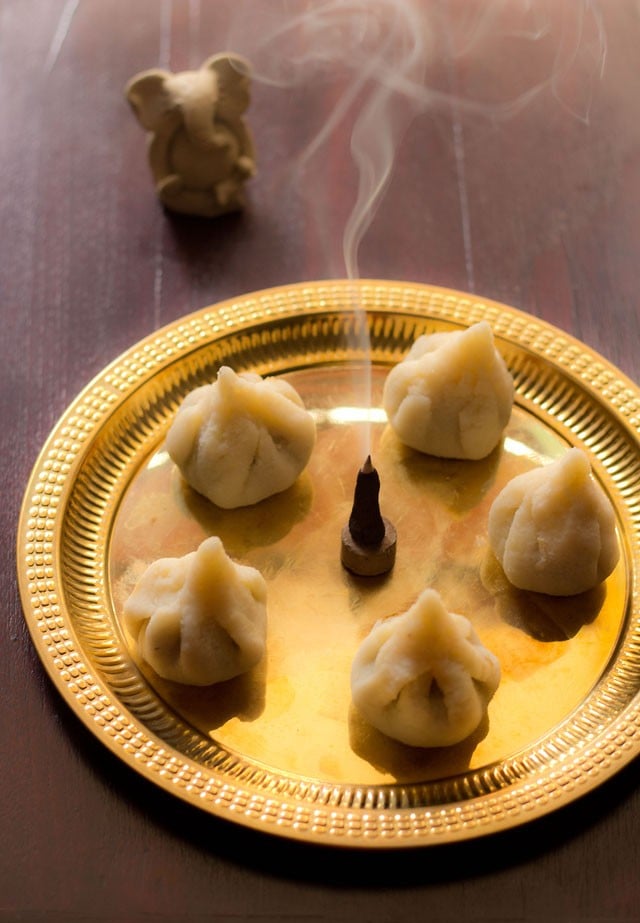
You can also use the modak mould to make things easy for you or do the traditional way of shaping with your hands.
If you prefer the mould then you can also check these other modak varieties as i have used the moulds while making these recipes and shown the method in stepwise photos:
For complicated recipes, generally I write step-by-step post and nowadays I have started making videos.
But for this recipe, I will be sharing both step by step post as well as a video. The recipe has been adapted from the Marathi cookbook “Annapurna” by Mangala Barve.
Note that if you are making this dish for Bhagwan Ganesha then make sure all your ingredients are fresh. Don’t taste any of the ingredients or sweet filling while cooking. Ensure purity and cleanliness. Cook with devotion and prayerfulness.
How to make Rava Modak
Make Coconut Stuffing
- In a heavy pan or kadai add 1.5 cups of powdered jaggery and 1.5 cups of grated fresh coconut. Keep the pan or kadai on a low heat. Stir the mixture often.
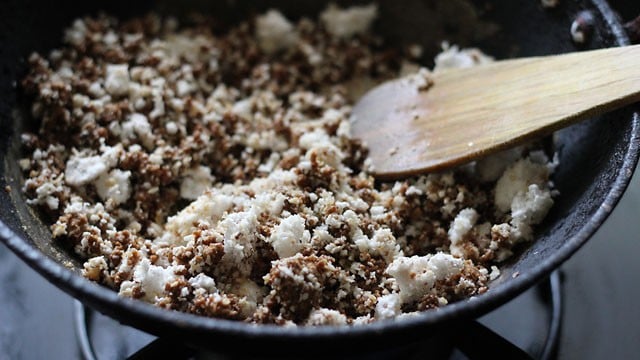
2. The jaggery would start melting at first. Later it will continue to cook. Cook this filling mixture till the jaggery starts thickening and there are no liquids in the mixture.
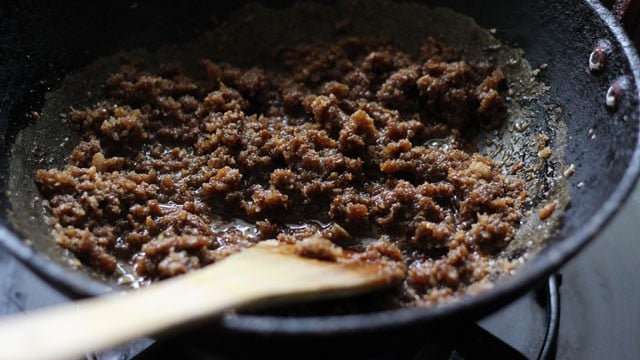
3. Don’t overcook as then the mixture would become dense and hard. Keep aside for cooling the filling. As the filling cools it will thicken.
Once the mixture is cooked then switch off the heat and add ½ teaspoon cardamom powder. Stir and mix well.
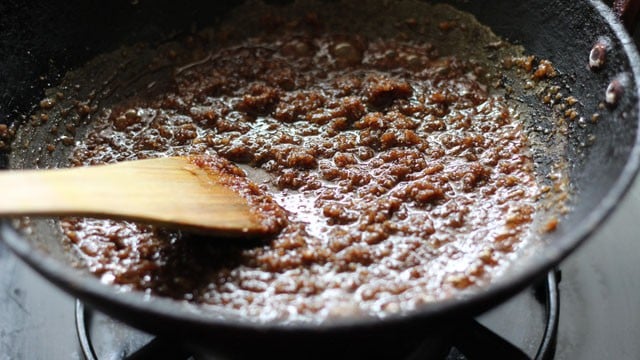
Make Rava Dough
4. Take 2.5 cups of water in a saucepan or any pan. Add 2 teaspoon oil or ghee and ¼ teaspoon salt in it.
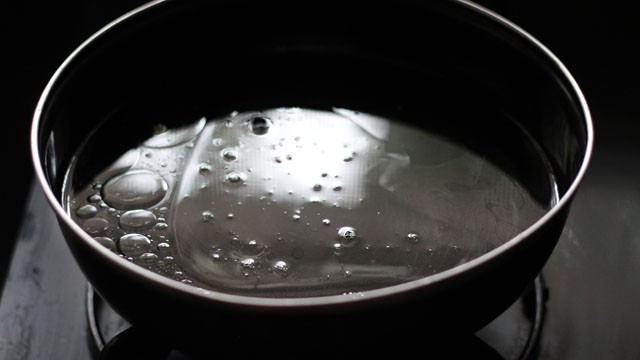
5. Bring the water to a rolling boil on medium-high to high heat. Once the water comes to a rolling boil then switch off the heat. Place the pan on kitchen countertop.
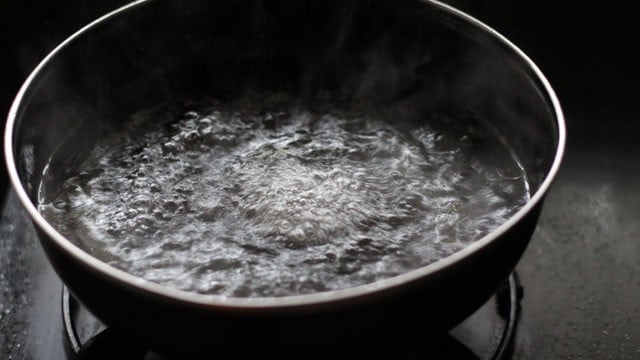
6. Add the semolina or rava to the hot water.
Make sure to use the finer variety of rava to make these modaks.
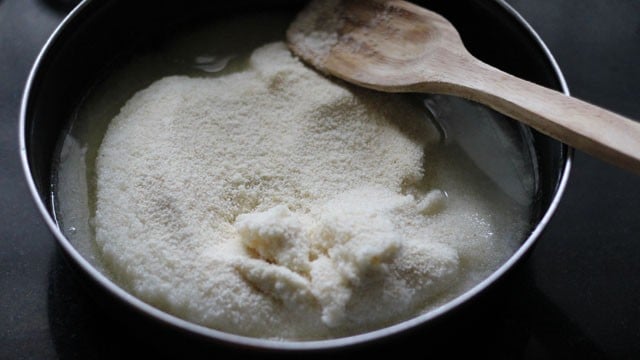
7. Stir with a wooden spatula or spoon till all the rava has been incorporated in the water. Mix really well.
Ensure that there are no lumps. If the rava mixture looks dry and loose then add a few tablespoons of hot water to it.
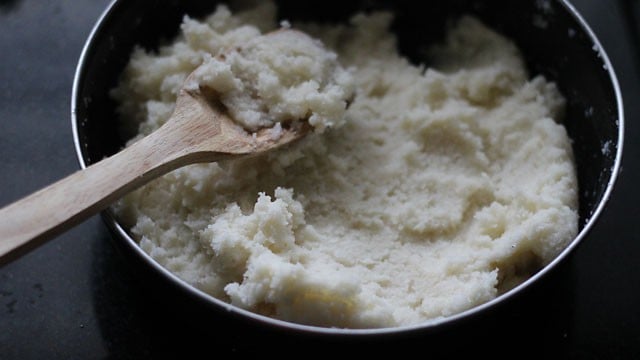
8. Now place this pan on low heat for 5 to 6 minutes. Continuously stir so that the rava does not stick and get burnt. After five minutes switch off the heat.
Cover the pan with a lid for 5 to 6 minutes. Taste a pinch of the dough (only if you are making this for your family). If the rava feels under cooked, then cook for a few more minutes.
Ensure that the rava is cooked well. Undercooked rava can give stomach aches.
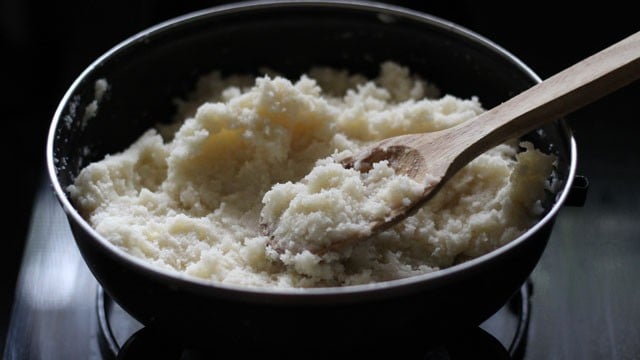
9. The dough would be still hot when the kneading has to be done. If you cannot manage the heat, then let it cool for a few minutes more.
Knead well and make a smooth dough. When kneading apply some oil on your palms. There should be no lumps in the dough after kneading.
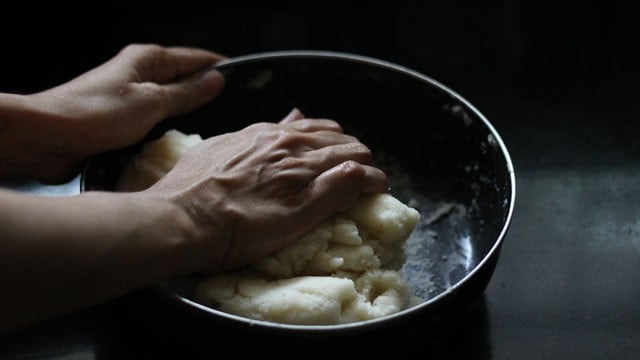
Make Rava Modak
10. Now take a lemon sized ball from the dough.
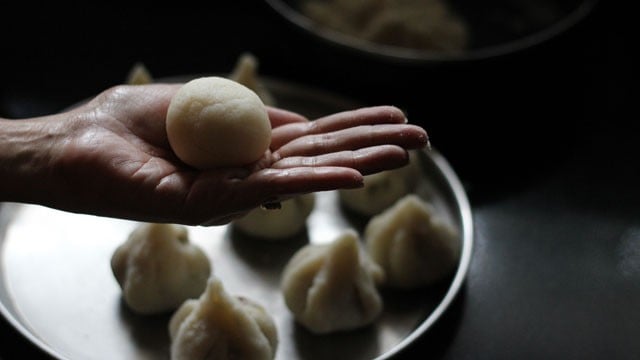
11. Flatten the dough ball on the palm of your hands
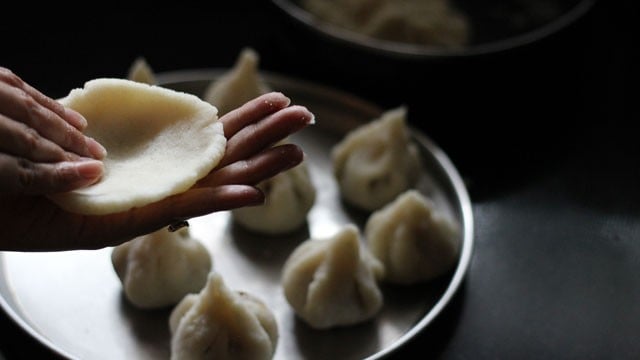
12. Or press the edges with your fingers and keep on moving the dough circle.
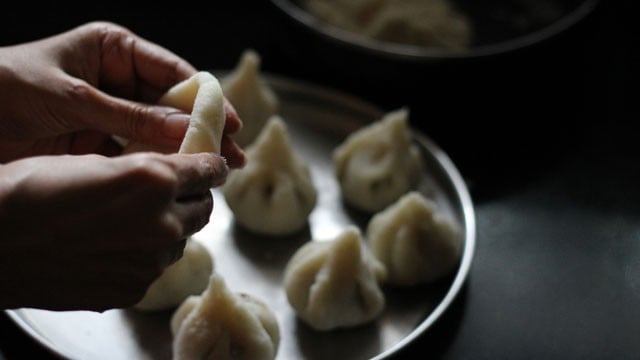
13. Place a few spoonfuls of the coconut-jaggery filling in the center.
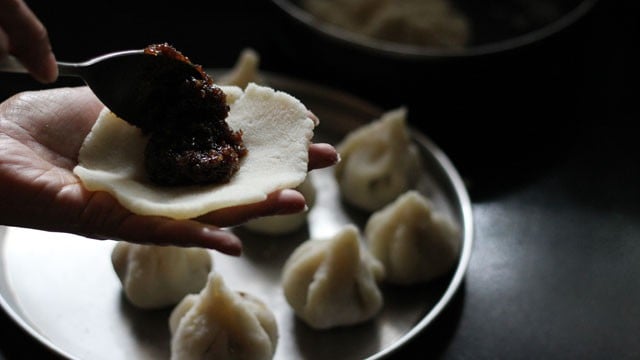
14. Pinch the edges and bring the fluted edges in the center.
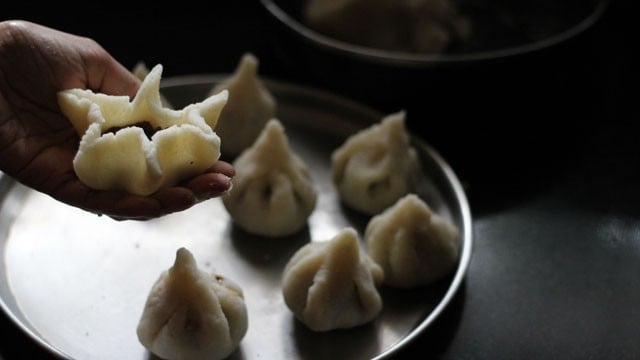
15. Join the center and pinch the top. Taper the top. Shape and make all the rava modak in a similar way.
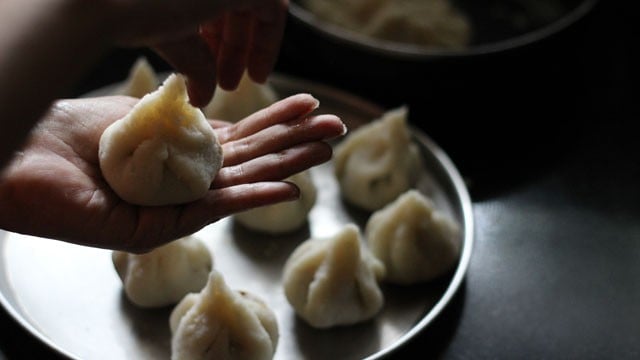
16. You don’t need to steam them further. Serve the rava modak to Bhagwan Ganesha.
You can also enjoy them as a sweet snack. It is best to have them as soon as they are made. Any leftover semolina modak kept in the fridge will become dense.
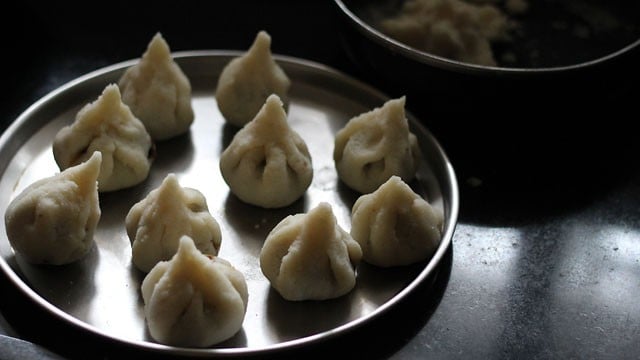
If you are looking for more Ganesh Chaturthi festival recipes then do check:
Please be sure to rate the recipe in the recipe card or leave a comment below if you have made it. For more vegetarian inspirations, Sign Up for my emails or follow me on Instagram, Youtube, Facebook, Pinterest or Twitter.
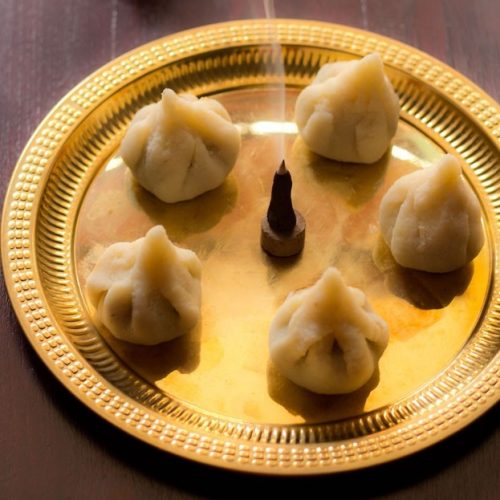
Rava Modak (Stuffed Semolina Modak)
Ingredients
- 2 cups semolina (fine sooji or fine rava)
- 1.5 cups grated coconut
- 1.5 cup powdered jaggery or add as required
- 2.5 cups water
- ½ teaspoon green cardamoms – or 4 to 5 green cardamoms crushed or powdered
- 2 teaspoon oil or ghee
- ¼ teaspoon salt or add as required
Instructions
Making the stuffing
- Mix the powdered jaggery with the coconut in a heavy pan or kadai.
- Keep the pan or kadai on a low heat. Stir the mixture often.
- The jaggery would start melting at first. Later it will continue to cook.
- Cook this filling mixture till the jaggery starts thickening. It should not have any liquids in it. Once the mixture has cooked then add the cardamom powder and mix well.
- Don’t over cook as then mixture would become dense and hard.
- Keep aside for cooling the filling. Note that as the filling cools it will thicken.
Making rava dough
- Take water in a saucepan or any pan. Add oil and salt in it.
- Bring the water to a rolling boil. When it comes to a rolling boil then switch off the heat and place it on the kitchen countertop.
- Add the semolina or rava to the hot water.
- Stir with a wooden spatula or spoon till all the semolina has been incorporated in the water.
- Mix really well. Now keep this pan on low heat for 5 to 6 minutes.
- Continously stir so that the rava does not stick and get burnt.
- After five minutes switch off the heat.
- Taste a pinch of the dough. (only if you are making this for your family and not for Bhagwan Ganesha).
- If the semolina feels undercooked, then cook for a few more minutes. Ensure that the rava is cooked well and not undercooked.
- Cover the pan with a lid for 5 to 6 minutes.
- The dough would be still hot when the kneading has to be done.
- If you cannot manage the heat, then let it cool for a few minutes more.
- Knead well and make a smooth dough.
- When kneading apply some oil on your palms. There should be no lumps in the dough after kneading.
Making rava modak
- Now take a lemon sized ball from the dough.
- Flatten the dough ball on the palm of your hands or with your fingers.
- Place a few spoonsfuls of the coconut-jaggery filling in the center.
- Pinch the edges and bring the fluted edges in the center.
- Join the center and pinch off the top. Taper the top.
- Make the rava modaks in a similar way.
- You don't need to steam them further.
- Serve rava modak to Bhagwan Ganesha.
Video
Nutrition Info (Approximate Values)
Rava Modak recipe from the blog archives was first published on July 2013.
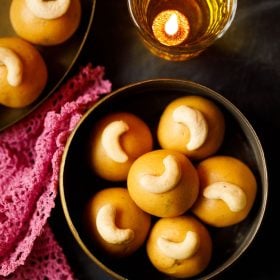
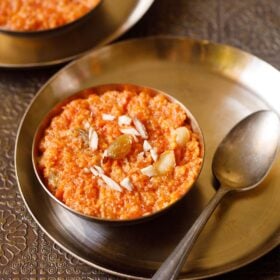
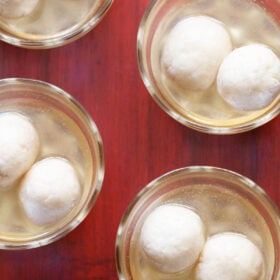
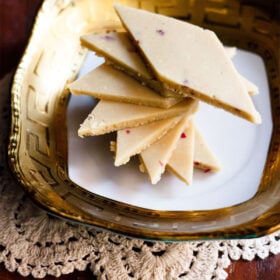








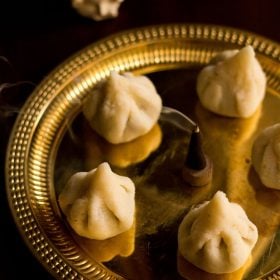
Used 1.5 cups of semolina instead of 2 cups, dough is easy to work with…..modaks turned out good, good recipe, thanks for sharing it!
Welcome Nupur. Thanks for your positive feedback on rava modak and for your suggestion.
thank u soo much for this recipe. it helped me a lot for making the modak…thankssss…….
welcome ayushi and thanks for the feedback. nice to know 🙂
Thanks for the lovely recipe, I tried this today and they came out really nice. The shapes weren’t so perfect but I was very happy with my first attempt! Thanks much for such a detailed step-by-step recipe 🙂
welcome kuntala. shaping the modaks need some practice. ready made modal moulds are also available in market few days before ganesh chaturthi festival.
Hi, thank you for this recipe, I used it to make modaks for the first time. I noticed that after some time had passed, the bottoms of the modaks became soaked with ghee/jaggery and it leaked out quite a bit over the day. Did I do something wrong or is this normal?
Happy Ganesh Chaturthi!
it happens in the process of steaming at times. its the jaggery. no worries. if there are cracks in the outer cover, or if the jaggery has moistness, then this happens.
amazing wonderful
How divine. The pictures, the recipe, the simplicity – all could only be performed by a genius. Thank you 🙂
welcome sapna and thanks for appreciating the pictures 🙂
Very innovative. My son is allergic to lot of foods and vegan seems to work for him.
I have a question. You use iron kadhai, how do you take care of the rusting part of it, i mean how to avoid rusting.
thanks. i use the kadhai often, so it does not rust. things only rust when you don’t use them. if you use iron cookwares regularly, they won’t rust. i don’t take any special care.
Made modaks using ur recipe. Came out perfect. Thanks 🙂
thanks rena
The pictures look absolutely divine…nice recipe too
what a lovely idea! i have never even heard of these before but not needing to steam them is a great plus. will try them for sure.
Love that stick of dhoop. Makes it all so peaceful and divine- Just like your modaks.
We too make this modak. sometimes we make it with chana dal stuffing… Lovely photographs 🙂